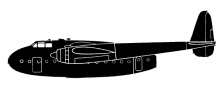
ASN Wikibase Occurrence # 336402
| Date: | Friday 20 May 1949 |
| Time: | 17:45 |
| Type: |  Fairchild C-82A Packet |
| Owner/operator: | United States Air Force - USAF |
| Registration: | 48-572 |
| MSN: | 10207 |
| Year of manufacture: | 1948 |
| Total airframe hrs: | 489 hours |
| Fatalities: | Fatalities: 0 / Occupants: 6 |
| Aircraft damage: | Destroyed, written off |
| Category: | Accident |
| Location: | Isachsen Airstrip, NU -
 Canada Canada
|
| Phase: | Take off |
| Nature: | Military |
| Departure airport: | Isachsen Airstrip, NU |
| Confidence Rating: |
A U.S. Air Force Douglas C-54 (42-72614) was stranded at Isachsen Airstrip and needed repairs. A C-82 was used to fly in the necessary parts and supplies. Cargo was loaded up to a gross weight of 50.000 pounds. The takeoff was to be made with a slight tail wind since the C-54 lay disabled at one end of the runway. A takeoff towards the C-54 was not deemed safe. A further difficulty would be the runway length and condition. The 2700 feet (usable length) earth runway was covered with 4-6 inches of finely powdered snow. The runway was 90 feet wide, flanked with 2 to 5 feet snowbanks.
Takeoff was commenced by a trainee pilot who had flown to Isachsen on other occasions. Flaps were not used. After travelling about 1000 feet the aircraft began to veer to the left. The pilot increased power on the left engine up to 60 inch manifold pressure and decreased power on the right engine to 30 inch manifold pressure. Both pilot applied full right rudder. The airplane continued to the left until the left main landing gear wheel struck the base of a snow bank. At a speed of 90 mph, the left propeller struck the snow bank, which caused the engine to be torn free from its mountings. The C-82 continued for 450 feet and came to rest after a left ground loop, completely wrecked.
Investigation revealed that the C-82 under the given conditions, required 3278 feet to become airborne.
Sources:
Army Air Forces Report of Major Accident, via oldwings.nl
Location
Revision history:
| Date/time | Contributor | Updates |
|---|
The Aviation Safety Network is an exclusive service provided by:


 ©2024 Flight Safety Foundation
©2024 Flight Safety Foundation